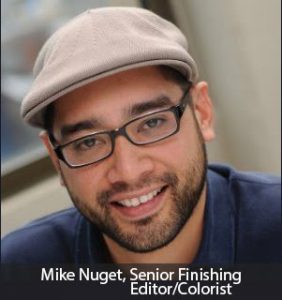 It was a lightbulb moment: Mike Nuget, formerly of PostWorks New York and currently a freelance colorist, realized that cineXtools could be used as an integral part of an online workflow. Since cineXtools can insert changes into a flattened file, such as a ProRes Quicktime, could one singular flattened file be used as the mezzanine between VFX, Color and final editorial? After hammering out the workflow details with Matt Schneider, PostWorks New York’s Director of Technology, they had a chance to try out his theory last year.
It was a lightbulb moment: Mike Nuget, formerly of PostWorks New York and currently a freelance colorist, realized that cineXtools could be used as an integral part of an online workflow. Since cineXtools can insert changes into a flattened file, such as a ProRes Quicktime, could one singular flattened file be used as the mezzanine between VFX, Color and final editorial? After hammering out the workflow details with Matt Schneider, PostWorks New York’s Director of Technology, they had a chance to try out his theory last year.
The Workflow
 “On the first project that we deployed this workflow, we graded in both Resolve and Baselight and onlined with Media Composer. ProRes 4444 is supported on all of these NLEs, and it’s also one of the codecs that cineXtools can insert-edit into,” Mike says. cineXtools can also insert edit into several other flat file formats such as DNxHD, XAVC, and XDCAM, but Mike chose ProRes 4444 because it’s a common format that is easy to work with and is universally supported by most post production tools.
“On the first project that we deployed this workflow, we graded in both Resolve and Baselight and onlined with Media Composer. ProRes 4444 is supported on all of these NLEs, and it’s also one of the codecs that cineXtools can insert-edit into,” Mike says. cineXtools can also insert edit into several other flat file formats such as DNxHD, XAVC, and XDCAM, but Mike chose ProRes 4444 because it’s a common format that is easy to work with and is universally supported by most post production tools.
“Since I was doing both online and color grading for this project, I would start out by exporting a flattened QT ProRes 4444 file for color. If there were changes once grading started, I would export patches from Avid and use cineXtools to insert these patches into the online master file. Since these files were considered “live” and being used simultaneously by the color platform, the files would automatically update and the color would reapply itself without any additional work from the colorist. We didn’t even need to close the file and re-open to commit the change. And with the multi-clip insert tab, I could insert several new shots at once.”
Mike’s lightbulb moment meant that cineXtools could become the keystone between different NLEs, providing a simple method to work with various tools that required no advanced preparation, nor special knowledge of traditional cross platform facilitators like AAFs or XMLs.
Comparing to a DPX workflow
“DPX is a very difficult format to work with within a facility, mostly because of DPX’s large size, and the enormous demands it places on a facility’s storage,” states Mike. “Naming the patch correctly is critical with DPX files and calculating an insert point using DPX frame counts isn’t necessarily intuitive and it’s easy to miscalculate.”
“With cineXtools if the source and timecode match up, you just can’t make a mistake with frame-accurate overwrites. And the patch can be named anything because the name of the file doesn’t affect its compatibility with the insert target. Also, the insert process is so fast that it’s easy to just jump between all the insert points to spot check that everything is as it should be.”
Comparing to an Export workflow
Mike explains, “Previous to using cineXtools and insert-edit, if there were a VFX shot change or segment that needed re-grading, then the colorist/editor/VFX artist would export a new ProRes file from their respective NLE to represent that change. It just meant a ton of exports and versions, opening up a Pandora’s Box about which versions had which fixes and whether the colorist or VFX editor placed the new shot correctly in a particular sequence.”
“Having to re-export at every step means more time, more storage space and some administrative wear and tear,” says Matt. “All the friction between final editorial and color grading goes away when you’re inserting into one, singular, monolithic file. There are no special tools required, nor any unique expertise needed, since everyone is working with a format they’re familiar with.”
“More specifically, re-exporting the entire project also creates additional work for the colorist or assistant colorist, as the flattened file needs to be re-notched in the color tool from an EDL. And once it has been re-notched, any existing grades from the previous iteration of the flattened file need to be copied over to the newly notched file. Although this process isn’t mechanically difficult, it still requires the faithful attention of a colorist, and it still needs to be checked, and it still takes time. All of this disappears when using cineXtools in this way, as an online management tool,” Matt continues.
“To add to Matt’s point, if cineXtools is used as the bridge that facilitates the online process, it doesn’t matter what color system is used – whether it’s Baselight, Resolve or Flame. Every NLE can export all the common codecs like DNx or ProRes. As an online editor, there’s no special AAF or XML to prep because we are all working on the same standard flat file,” Mike adds.
“It’s been fun to think of new and creative ways to use cineXtools,” says Mike. “It’s been an ace up my sleeve for a couple of different projects, especially for clients who weren’t initially ready to adopt this kind of finishing workflow with cineXtools. On one episodic show, we kept the idea of working with a flat file as our working master. We called this file the ‘tape file’ because our client had up until last year used tape as their mezzanine. Just like tape, we inserted whatever fixes were necessary and then created everything from viewing copies to the final network delivery from our ‘tape file’ which was just a padded ProRes 4444.”
As a final comment, Matt adds, “cineXtools has made finishing workflows that use a flat file faster and more comfortable for all teams involved. It has helped us with our core mission, which is to create efficiencies and reduce friction for all facility workflows under our roof.”
About Technicolor PostWorks New York
Technicolor – PostWorks New York is the largest post production facility in New York, providing comprehensive services for film, television and commercials through an exceptional team of artists, engineers and project managers. We offer unsurpassed resources for dailies processing (on-set and off-site), color grading, editorial finishing and visual effects, and feature the most flexible digital intermediate infrastructure in our market. Through PostWorks New York, we also offer non-linear editing systems (available on-site or on-location) and complete sound services. Our Test Lab is a unique resource, providing pre-flight consultation with expertise in digital cinema camera systems and data formats, data management and workflow design. http://www.postworks.com/technicolorpwny/contact/west-village-leroy/
About Mike Nuget
Mike Nuget began his career at Rhinoceros Editorial in 2003. Among his first credits was as assistant editor on Michael Moore’s ground-breaking documentary Fahrenheit 9/11. Since then, Mike has worked in virtually every picture genre – from commercials and promos, to reality and network television, to narrative and documentary films – and has honed a diverse skill set across multiple platforms, including DaVinci’s Resolve, Filmlight’s Baselight, AVID & some Autodesk Flame work. Mike’s versatility has secured him strong relationships with our vendors, particularly AVID and Filmlight, for whom he has spearheaded several presentations demonstrating workflows he helped create alongside these two industry leaders.
Nuget was a member of the Technicolor-PostWorks team from 2005 – 2018. Recently, he has been applying those skills to television projects and documentaries, including the FX series The Americans, Netflix’s docu-series Rotten, ABC drama Quantico, TV Land’s Younger, PBS documentary series Soundbreaking – Stories from the Cutting Edge of Recorded Music, and recent Academy Award Nominated short, Edith & Eddie. https://www.mikenuget.com

